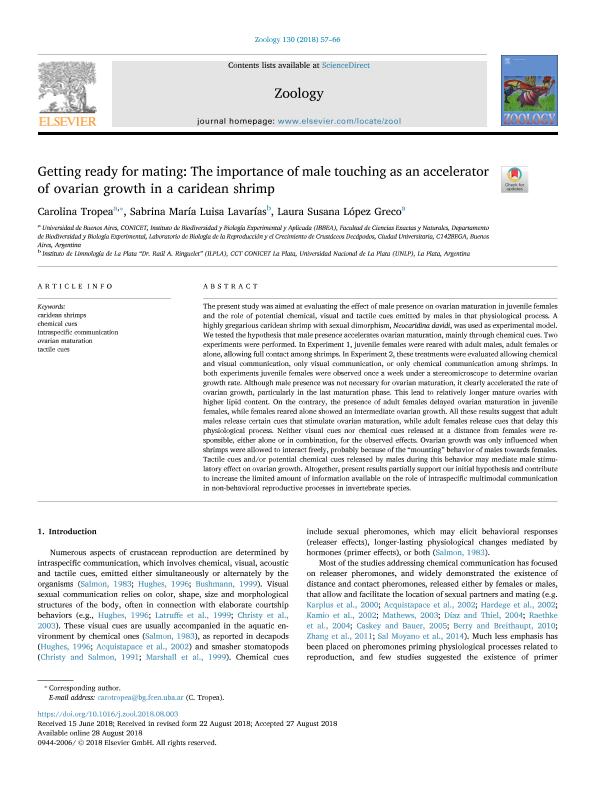Mostrar el registro sencillo del ítem
dc.contributor.author
Tropea, Carolina

dc.contributor.author
Lavarias, Sabrina Maria Luisa

dc.contributor.author
Lopez, Laura Susana

dc.date.available
2019-08-14T18:05:24Z
dc.date.issued
2018-10
dc.identifier.citation
Tropea, Carolina; Lavarias, Sabrina Maria Luisa; Lopez, Laura Susana; Getting ready for mating: The importance of male touching as an accelerator of ovarian growth in a caridean shrimp; Elsevier Gmbh; Zoology; 130; 10-2018; 57-66
dc.identifier.issn
0944-2006
dc.identifier.uri
http://hdl.handle.net/11336/81599
dc.description.abstract
The present study was aimed at evaluating the effect of male presence on ovarian maturation in juvenile females and the role of potential chemical, visual and tactile cues emitted by males in that physiological process. A highly gregarious caridean shrimp with sexual dimorphism, Neocaridina davidi, was used as experimental model. We tested the hypothesis that male presence accelerates ovarian maturation, mainly through chemical cues. Two experiments were performed. In Experiment 1, juvenile females were reared with adult males, adult females or alone, allowing full contact among shrimps. In Experiment 2, these treatments were evaluated allowing chemical and visual communication, only visual communication, or only chemical communication among shrimps. In both experiments juvenile females were observed once a week under a stereomicroscope to determine ovarian growth rate. Although male presence was not necessary for ovarian maturation, it clearly accelerated the rate of ovarian growth, particularly in the last maturation phase. This lead to relatively longer mature ovaries with higher lipid content. On the contrary, the presence of adult females delayed ovarian maturation in juvenile females, while females reared alone showed an intermediate ovarian growth. All these results suggest that adult males release certain cues that stimulate ovarian maturation, while adult females release cues that delay this physiological process. Neither visual cues nor chemical cues released at a distance from females were responsible, either alone or in combination, for the observed effects. Ovarian growth was only influenced when shrimps were allowed to interact freely, probably because of the “mounting” behavior of males towards females. Tactile cues and/or potential chemical cues released by males during this behavior may mediate male stimulatory effect on ovarian growth. Altogether, present results partially support our initial hypothesis and contribute to increase the limited amount of information available on the role of intraspecific multimodal communication in non-behavioral reproductive processes in invertebrate species.
dc.format
application/pdf
dc.language.iso
eng
dc.publisher
Elsevier Gmbh

dc.rights
info:eu-repo/semantics/openAccess
dc.rights.uri
https://creativecommons.org/licenses/by-nc-sa/2.5/ar/
dc.subject
Caridean Shrimps
dc.subject
Chemical Cues
dc.subject
Intraspecific Communication
dc.subject
Ovarian Maturation
dc.subject
Tactile Cues
dc.subject.classification
Biología Reproductiva

dc.subject.classification
Ciencias Biológicas

dc.subject.classification
CIENCIAS NATURALES Y EXACTAS

dc.title
Getting ready for mating: The importance of male touching as an accelerator of ovarian growth in a caridean shrimp
dc.type
info:eu-repo/semantics/article
dc.type
info:ar-repo/semantics/artículo
dc.type
info:eu-repo/semantics/publishedVersion
dc.date.updated
2019-07-26T13:39:22Z
dc.journal.volume
130
dc.journal.pagination
57-66
dc.journal.pais
Alemania

dc.journal.ciudad
Berlín
dc.description.fil
Fil: Tropea, Carolina. Consejo Nacional de Investigaciones Científicas y Técnicas. Oficina de Coordinación Administrativa Ciudad Universitaria. Instituto de Biodiversidad y Biología Experimental y Aplicada. Universidad de Buenos Aires. Facultad de Ciencias Exactas y Naturales. Instituto de Biodiversidad y Biología Experimental y Aplicada; Argentina
dc.description.fil
Fil: Lavarias, Sabrina Maria Luisa. Consejo Nacional de Investigaciones Científicas y Técnicas. Centro Científico Tecnológico Conicet - La Plata. Instituto de Limnología "Dr. Raúl A. Ringuelet". Universidad Nacional de La Plata. Facultad de Ciencias Naturales y Museo. Instituto de Limnología; Argentina
dc.description.fil
Fil: Lopez, Laura Susana. Consejo Nacional de Investigaciones Científicas y Técnicas. Oficina de Coordinación Administrativa Ciudad Universitaria. Instituto de Biodiversidad y Biología Experimental y Aplicada. Universidad de Buenos Aires. Facultad de Ciencias Exactas y Naturales. Instituto de Biodiversidad y Biología Experimental y Aplicada; Argentina
dc.journal.title
Zoology

dc.relation.alternativeid
info:eu-repo/semantics/altIdentifier/url/https://www.sciencedirect.com/science/article/pii/S094420061830117X
dc.relation.alternativeid
info:eu-repo/semantics/altIdentifier/doi/http://dx.doi.org/10.1016/j.zool.2018.08.003
Archivos asociados
